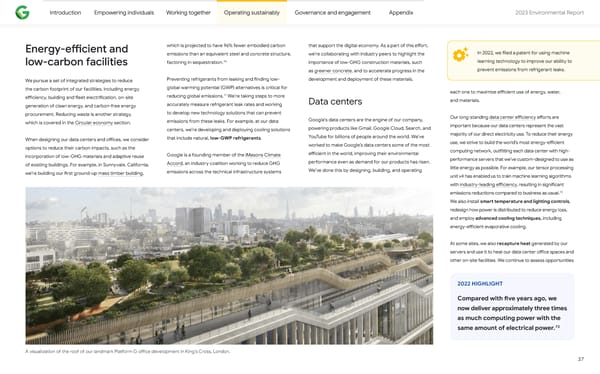Introduction Empowering individuals Working together Operating sustainably Governance and engagement Appendix 2023 Environmental Repo爀琀 that suppo爀琀 the digital economy. As a pa爀琀 of this e昀昀o爀琀, which is projected to have 96% fewer embodied carbon Energy-e昀케cient and In 2022, we 昀椀led a patent for using machine we’re collaborating with industry peers to highlight the emissions than an equivalent steel and concrete structure, 70 learning technology to improve our ability to impo爀琀ance of low-GHG construction materials, such low-carbon facilities factoring in sequestration. prevent emissions from refrigerant leaks. as greener concrete, and to accelerate progress in the Preventing refrigerants from leaking and 昀椀nding low- development and deployment of these materials. We pursue a set of integrated strategies to reduce global warming potential (GWP) alternatives is critical for the carbon footprint of our facilities, including energy each one to maximize e昀케cient use of energy, water, 71 reducing global emissions. We’re taking steps to more e昀케ciency, building and 昀氀eet electri昀椀cation, on-site and materials. Data centers accurately measure refrigerant leak rates and working generation of clean energy, and carbon-free energy procurement. Reducing waste is another strategy, to develop new technology solutions that can prevent Our long-standing data center e昀케ciency e昀昀o爀琀s are Google’s data centers are the engine of our company, emissions from these leaks. For example, at our data which is covered in the Circular economy section. impo爀琀ant because our data centers represent the vast powering products like Gmail, Google Cloud, Search, and centers, we’re developing and deploying cooling solutions majority of our direct electricity use. To reduce their energy YouTube for billions of people around the world. We’ve that include natural, low-GWP refrigerants. When designing our data centers and o昀케ces, we consider use, we strive to build the world’s most energy-e昀케cient worked to make Google’s data centers some of the most options to reduce their carbon impacts, such as the computing network, ou琀昀i琀琀ing each data center with high- e昀케cient in the world, improving their environmental Google is a founding member of the iMasons Climate incorporation of low-GHG materials and adaptive reuse pe爀昀ormance servers that we’ve custom-designed to use as pe爀昀ormance even as demand for our products has risen. Accord, an industry coalition working to reduce GHG of existing buildings. For example, in Sunnyvale, California, li琀琀le energy as possible. For example, our tensor processing We’ve done this by designing, building, and operating emissions across the technical infrastructure systems we’re building our 昀椀rst ground-up mass timber building, unit v4 has enabled us to train machine learning algorithms with industry-leading e昀케ciency, resulting in signi昀椀cant 72 emissions reductions compared to business as usual. We also install sma爀琀 temperature and lighting controls, redesign how power is distributed to reduce energy loss, and employ advanced cooling techniques, including energy-e昀케cient evaporative cooling. At some sites, we also recapture heat generated by our servers and use it to heat our data center o昀케ce spaces and other on-site facilities. We continue to assess oppo爀琀unities 2022 HIGHLIGHT Compared with 昀椀ve years ago, we now deliver approximately three times as much computing power with the 73 same amount of electrical power. A visualization of the roof of our landmark Pla琀昀orm G o昀케ce development in King’s Cross, London. 37
 2023 Environmental Report Page 36 Page 38
2023 Environmental Report Page 36 Page 38